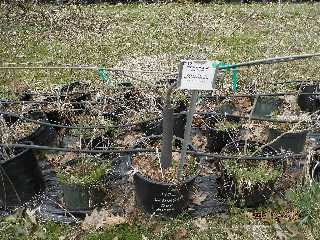

Apple Trees Espalier trained (pictures of) being trained for our Retail Plant Sale at the flowering shrub farm in Voorheesville, NY. We train fruit trees and crabapple trees for sale to belgian fence, step over or horizontal T. If the pictures below dont open click applebuy. Click a picture will open a larger image that you can study up close.
112 Stayman Winesap being trained to stepover and horizontal t. In the first year I cut the trees back to 18 inches above the soil line or 15 inches above the graft. We remove all growth except three good branches (if available).
One of the pictures shows a sign with the quantity available for sale in a 7 gallon pot for $30 on a green dot. No colored dot? None for sale (or it may have faded, check after I do my next inventory). Click for larger image. yellow dot is 15 gallon for $50.
219 Liberty Apple tree that we alternate with the cross pollinator Stayman Winesap or Arkansas Black
220 Arkansas Black apple tree that we alternate with the cross pollinator Liberty
221 Donald Wyman crab apple tree being trained to belgian fence, step over and horizontal t.
Dwarf 'Newtown Pippin' Apple Espalier I over write these pictures frequently so you might want to reload the page to ensure your computer doesn't have it cached.
'Snowdrift' Flowering Crab Apple Espalier In the first year I cut the trees back to 18 inches above the soil line or 15 inches above the graft. We remove all growth except three good branches (if available). The best will be trained to horizontal T. Those with only two branches will be trained to step over or belgian fence. A few may have only one branch and may be trained as stepover as wll.

The espalier is a restrictive form of fruit tree training (though it has been applied to many other types of plants) where trees or vines are tied and pruned so that the plant has a central stem that supports a number of paired branches that are trained in a single plane by tieing onto a trellis. Most people are more familiar to espalier as it is used in a vinyard to train grape vines.

In the above picture The stem on the left has been lowered to the horizontal, having already grown to around three feet long (in the horizontal position the leader wont lengthen as quickly while fruit spur production is increased). The stem on the right is a foot shorter and has been trained to a slightly more vertical position so it will grow a bit longer before being lowered as well. In the center I am training another stem up to the top wire for horizontal T.
A standard tree, may overshadow four hundred square feet of orchard. When replaced with 25 horizontal T espalier trained trees, six feet apart on 6 paralel trellises that are twenty five feet long and six feet apart (that uses the same square feet of space), each trees fruit is thinned to twenty fruit and you have five hundred fruit each larger than those on the standard because they have twenty five seperate root systems. The leaves and stems of espalier trained trees and vines are easier to examine for damaging insects and preventative sprays are easier to apply. Traps for insects can be hung from the trellis and how bad the infestation is can be determined by counting how many insects were caught. Much of the time a standard apple tree needs is in the development of the stem needed to support all those fruit. An espalier because its on a trellis has an immediate support in the posts and wires. The added advantage of being able to train many different fruit together (apples, pears, plums, peaches, apricots, blackberries, raspberries etc.) in a small area no doubt has added to espaliers popularity. By running trellises from North to South the trees receive the maximum light possible during summer when the sun travels from east to west. In winter, when the sun is in the south each tree over shadows the one to its immediate north providing maximum protection from sunscald. In more southerly climates like the one that prevails in the mediteranean, trees can be trained onto a south facing wall or hillside where added sunlight later in the year will extend the growing season but in a climate where temperatures drop below freezing, warming the stem on a sunny wall during the day so the sap starts to run, then having temperatures drop again to below freezing at night, can cause sun scald damaging the stem and reducing its ability to produce fruit.

Tying trees to a trellis as belgian fence.

We attach pvc sprinklers to the top of posts helping hold the posts apart while providing a simple way to water.

All year as I do inventory or train trees I take pictures that are added to my PICTURE-NEWSLETTER for that month. When those pictures are of espalier I add them here as well. January February March April May 1 to 15 May 16 to 31 June 1 to 7 June 8 to 14 June 15 to 21 June 22 to 30 July August September October November December
andyvancleve flowers.yonatan.us